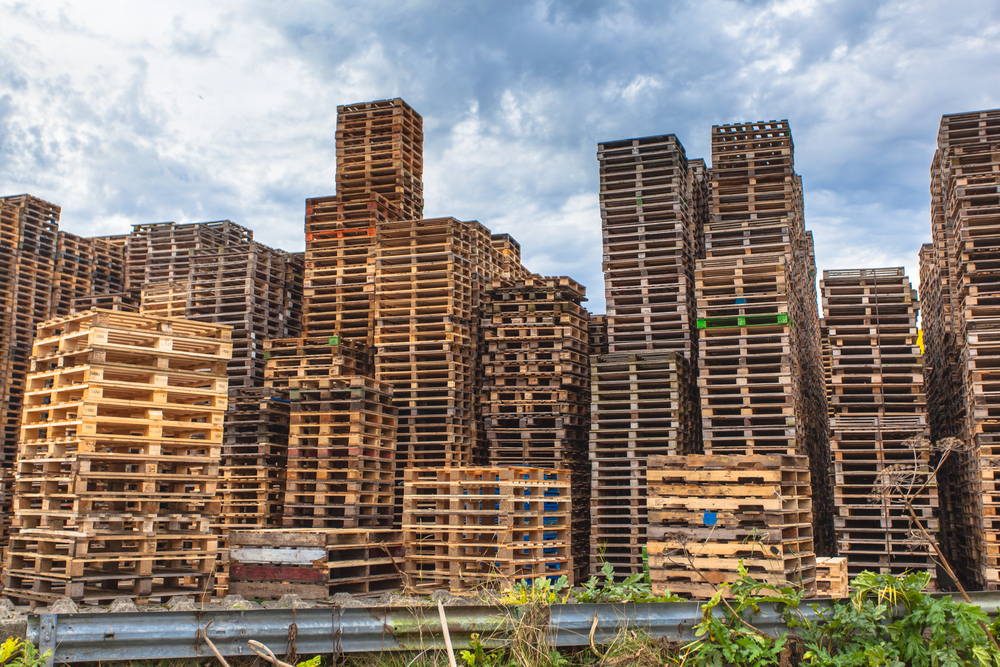Avoid These Mistakes When Choosing Used Timber Pallets
Used timber pallets can be used again. However, there are certain things you have to be aware of before reuse. Otherwise you risk damaging your stock, the pallet, and possibly people operating within the area.
In this blog, we will show you the mistakes to avoid when choosing used timber pallets.
A and M Pallets Ltd is an established and respected supplier and producer of a wide array of pallets. Our services are designed to provide many industries with safe, strong and superior pallets of many varieties.
Our solutions are sure to help those in need of pallets for all sorts of logistical needs. We provide full pallet delivery and collection services in Cornwall, Devon, Somerset, Dorset, Wiltshire, and Avon.
How long do used timber pallets generally last?
The lifespan of a used timber pallet is highly variable,and can depend on a few factors. That being said, its lifespan can also be extended.
Average Lifespan:
- General Use: A typical timber pallet used in standard shipping and warehousing can last anywhere from 3 to 7 years. This is a broad range, as usage intensity and environmental conditions play a significant role.
- Pooled Pallets: Pallets within a pooling system (where pallets are rented and reused) often have a shorter lifespan, averaging around 5 years. This is due to the higher frequency of use and transportation.
Factors Affecting Lifespan:
- Wood Type: Hardwood pallets (like oak) are more durable than softwood pallets (like pine) and tend to last longer.
- Construction Quality: Well-constructed pallets with strong joints and secure fasteners will generally last longer than poorly constructed ones.
- Usage Intensity: Pallets that are frequently used and subjected to heavy loads will wear out faster than those used for lighter loads or less frequent transport.
- Handling Practices: Rough handling with forklifts or pallet jacks can cause damage and shorten pallet lifespan.
- Storage Conditions: Pallets stored outdoors are exposed to weather elements like rain, sun, and temperature fluctuations, which can lead to rot, decay, and warping. Indoor storage in dry conditions significantly extends lifespan.
- Maintenance and Repair: Regular inspection and repair of damaged pallets can significantly extend their lifespan.
Extending Pallet Lifespan:
- Proper Handling: Train employees on proper handling procedures to minimise damage.
- Indoor Storage: Store pallets indoors or under cover to protect them from the elements.
- Regular Inspections: Conduct regular inspections to identify and repair damage early on.
- Preventative Maintenance: Apply protective coatings or sealants to protect the wood from moisture and pests.
Avoid these mistakes when choosing used timber pallets

Choosing used timber pallets can be a cost-effective option for various purposes, from shipping and storage to DIY projects. However, it’s crucial to be vigilant and avoid certain mistakes to ensure you’re getting usable, safe, and cost-effective pallets. Here’s a detailed list of common pitfalls to avoid:
1. Ignoring Structural Integrity:
Broken or Missing Boards:
Thoroughly inspect each pallet for broken, cracked, or missing boards. These structural weaknesses compromise the pallet’s load-bearing capacity and can lead to product damage or safety hazards. Pay close attention to the stringers (the long, vertical boards) and the deck boards (the horizontal boards).
Loose Nails or Fasteners:
Check for loose, protruding, or missing nails, screws, or other fasteners. These can cause injuries or damage to goods. Ensure all fasteners are securely in place.
Warping or Twisting:
Look for signs of warping or twisting in the pallet structure. This can indicate that the pallet has been exposed to moisture or excessive stress, compromising its stability. A warped pallet won’t stack properly and can be dangerous.
Rot or Decay:
Inspect the wood for signs of rot, decay, or fungal growth. This is especially important for pallets that have been stored outdoors. Rotting wood is weak and can easily break under load. Check for discolouration, soft spots, and a musty odor.
2. Overlooking Sanitary Concerns:
Stains and Spills:
Check for stains, spills, or other signs of contamination. These can indicate that the pallet has been used to transport hazardous materials or food products that could pose a health risk. Avoid pallets with oil, chemical, or food stains.
Infestation:
Inspect the pallet for signs of insect infestation, such as small holes, sawdust, or live insects. Pests can damage stored goods and spread to other areas. Look for evidence of wood-boring beetles, termites, or other pests.
Mould and Mildew:
As mentioned earlier, check for mould and mildew growth, especially in crevices and hard-to-reach areas. Mould and mildew can cause health problems and damage stored goods.
3. Failing to Check for Heat Treatment or Methyl Bromide Fumigation Marks:
IPPC Markings:
Look for the IPPC (International Plant Protection Convention) stamp. This mark indicates that the pallet has been treated to prevent the spread of pests. The most common treatments are heat treatment (HT) and methyl bromide fumigation (MB).
Avoiding MB Pallets:
Methyl bromide is a toxic pesticide that is being phased out in many countries. Avoid pallets marked with MB, as they can pose a health risk. Heat-treated (HT) pallets are a safer and more environmentally friendly option. No marking means the pallet is for domestic use only, within the country of origin.
4. Not Considering Pallet Size and Type:
Size Compatibility:
Ensure the pallet size is compatible with your storage space, handling equipment (forklifts, pallet jacks), and transportation methods. Using the wrong size can lead to inefficiencies and increased costs.
Pallet Type:
Different types of pallets exist (stringer pallets, block pallets, etc.). Choose the type that is best suited for your specific needs. Stringer pallets are the most common and are suitable for most general applications.
5. Neglecting the Source and History of the Pallets:
Reputable Suppliers:
Source used pallets from reputable suppliers who inspect and grade their pallets. This reduces the risk of receiving damaged or contaminated pallets.
Knowing the Pallet’s History:
If possible, try to determine the pallet’s previous use. Pallets that have been used to transport food or pharmaceuticals are generally cleaner and safer than those used to transport chemicals or other hazardous materials.
6. Focusing Solely on Price:
Quality over Cost:
While price is an important factor, don’t sacrifice quality for a lower price. Cheap pallets might have hidden damage or structural weaknesses that can lead to costly problems down the line.
7. Ignoring Safety Precautions:
Wear Gloves and Protective Gear:
When handling used pallets, wear gloves and protective gear to protect yourself from splinters, nails, and potential contaminants.
Inspect in a Well-Lit Area:
Inspect pallets in a well-lit area to ensure you can clearly see any damage or defects.
Where to find used timber pallets

As the South West’s largest independent producer and supplier of new and reconditioned pallets, we at A and M Pallets Ltd pride ourselves on providing unrivalled services and the best possible pallets since 1989.
Our hard work, in addition to our loyal and ever-expanding customer base, has allowed us to provide comprehensive coverage through the South West and further afield though our four sites in St. Austell, Tavistock, Launceston and Willand.
Producing over 45,000 pallets a month, you can be sure we will have what you are looking for, whether it is used pallets, new pallets, plastic pallets or ISPM15 heat treated pallets, we are here to help.
In this blog, we hope to have shown you the mistakes to avoid when choosing used timber pallets. Whilst providing helpful additional information, including our unparalleled services. Our expert team is here to help you on each step of your journey with us, for more information, you can contact us here, or find us below at:
Head Office:
- Unit One Northcott Hamlet
- Launceston
- Cornwall
- PL15 9RQ
- T: 01409 211386
- E: admin@aandmpallets.co.uk
- Mon – Fri: 9am to 5pm
ST. Austell Office:
- Brighton Cross
- Grampound Road
- Truro
- Cornwall
- TR2 4HD
- T: 01726 882122
- E: info@aandmpallets.co.uk
- Mon – Fri: 8am to 5pm
Tavistock Office:
- Haye Down Ind. Est.
- Chillaton
- Tavistock
- Devon
- PL19 0NN
- T: 01822 860456
- E: info@aandmpallets.co.uk
- Mon – Fri: 7am to 5pm
Willand Office:
- 5 Willand Rd Bus. Park
- Willand Road
- Willand
- Devon
- EX15 2RF
- T: 01884 841942
- E: info@aandmpallets.co.uk
- Mon – Fri: 8.30am to 4.30pm
